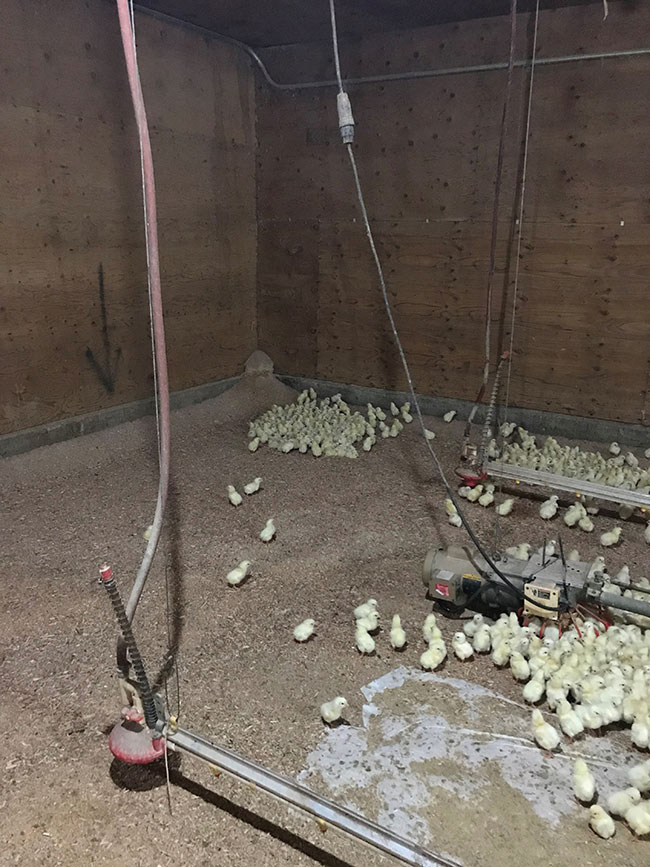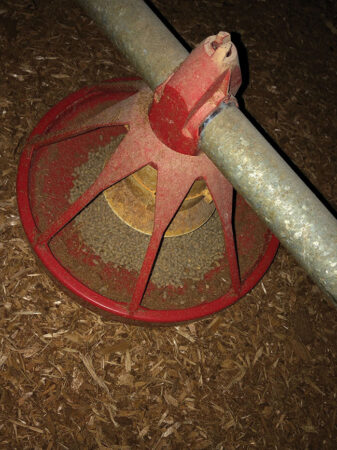
The skinny on starve-outs
By Jane Robinson
Features Broilers TurkeysAs the name suggestions, starve-outs refer to young chicks that die from starvation. This article looks at common causes and preventative measures.
 When chicks are cold, they’ll often huddle together and stop looking for feed and water.
PHOTO CREDIT: Dr. Gigi Lin
When chicks are cold, they’ll often huddle together and stop looking for feed and water.
PHOTO CREDIT: Dr. Gigi Lin As the name suggestions, starve-outs refer to young chicks that die from starvation. The condition happens mostly in chicks and poults but can also occur in older birds.
While starve-outs are not a prevalent problem, they can be mistaken for other conditions, according to Dr. Gigi Lin, a poultry veterinarian at Canadian Poultry Consultants in Abbotsford, B.C. She estimates that one out of every 50 cases of chick mortality in her practice results from starvation or dehydration. The silver lining is that the causes of starve-outs are usually straightforward and identifiable, and there are easy steps to correct and prevent it.
After hatching, chicks continue to benefit from yolk sac nutrients for a few days. But if they don’t have external source of feed or water after that, they are prone to starvation. “The prime time we see starvation in chicks and poults is at three to five days of age, after the yolk sac has been completely absorbed,” says Lin.
The root cause
There are two key causes of starve-outs – the availability and the accessibility of feed and water for birds.
Availability refers to situations where birds physically don’t have feed and water because of human error. The water line could be clogged, the feed line might be positioned too high for the birds to reach, or the crumble size of the feed might be too big for chicks. “These situations are completely preventable by properly preparing the barn before birds arrive,” says Lin.
Accessibility is the second biggest cause of starve-outs. Feed and water is available to chicks, but they may not be accessing it. “The main reason this happens is if birds don’t feel comfortable, for example, because they are too cold,” she says. Lin sees this in the winter if the temperature isn’t right or there are draughts in the barn, causing chicks to focus on huddling for warmth instead of looking for food.
Carbon dioxide levels can also be a contributing factor to starve-outs, and turkey poults are more susceptible. When C02 levels are too high, birds get sleepy and their metabolism slows down. They feel cold, huddle together and stop looking for feed and water. “I see this more in the winter when ventilation is too tight,” says Lin. “Levels of C02 above about 3,000 ppm are too high and for turkey poults I want C02 to be under 2,500 ppm.”
What’s the impact
The obvious impact when chicks don’t get feed and water is that they die from starvation or dehydration. For chicks that don’t die and are then supplied with feed and water, they often survive but their gut health and immune system could be impacted and manifest as performance issues down the road. “You might see a flock that is smaller with less uniformity, compared to one with no interruption in nutrition, which would be a significant impact in a broiler flock,” says Lin.
Treatment and prevention
If Lin suspects starve-outs, she suggests producers evaluate farm conditions, especially feed and water accessibility as well as ventilation. Depending on the cause, will determine how widespread the problem could be in a flock. “Most of the time, the issue is in a particular area of the barn and producers are seeing spotty mortality throughout the barn.”
When a problem is detected, the treatment is usually straightforward – find the cause and correct it. Most of the time, birds will bounce back. Sometimes Lin suggests providing birds with some extra feed and a multivitamin in the drinking water for a few days to give them an extra boost.
“Depending on how long birds are without feed and water will impact the possibility of future gut health or immune function, and the consequences can be quite different depending on if they happen in broiler chicks, layers or turkeys.”
When it comes to prevention, Lin finds that experience coupled with education and information is the best way to reduce the occurrence of starve-outs in a flock. She credits the late Dr. Stewart Ritchie – who started Canadian Poultry Consultants – with developing the Platinum Brooding program offered by their practice, to teach producers about optimal brooding management.

Pictured here is a half empty feed pen with a crumble size that was too big.
PHOTO CREDIT: Dr. Gigi Lin
Top tips for producers
Lin offers three tips for producers when it comes to starve-outs.
- Do a crop fill check. Lin highly recommends producers do a thorough barn check 24 hours after chicks have been placed. Take a laundry basket and collect 100 chicks throughout the barn to get a representative sample. Palpate each chick to feel the size of the crop – the area in the neck where feed is stored. The crop should feel full, soft and moist because it contains a mix of feed and water. It should not be firm or hard. “If 95 per cent of chicks sampled have a full crop, that’s a very good indication they are getting enough feed and water,” says Lin. “If it’s less than 95 per cent, I go through a checklist to try and figure out why they aren’t getting enough feed intake.”
The 24-hour mark is a critical time to check because if an error is found at this point, there’s a good chance it can be corrected before chicks get to the three days of age when starve-outs tend to occur. - Prepare for arrival. Get pens ready one or two days before chicks arrive, if possible, recommends Lin. “If it’s winter, you might want to preheat the barn and adjust the water temperature,” she says. “Walk through the barn to make sure all the feed lines and trigger pans are working, the feed is the correct size and all the residual disinfectant has been flushed from the water lines.”
- Get an accurate diagnosis. Any time there is unexplained high mortality, Lin recommends producers submit chicks to their veterinarian or pathologist right away to get an accurate diagnosis. “Don’t assume all early chick mortality is caused by yolk sac infections or omphalitis.”
Diagnosing starve-outs
Lin pays particularly close attention to flocks that have a very high mortality rate after three days of age. “This is a critical period when chicks are prone to starvation,” she says. There are two criteria for diagnosis of starve-outs that Lin looks for. The first is a lack of feed in the crop, gizzard, and the rest of the intestinal tract – sometimes the crop may feel full, but it might be shavings they are picking up instead of feed. The second criteria is if she can’t find any other lesions or signs of infection.
“At a farm level, when you look at a dead chick at five days of age, it is hard to tell if it died from starvation or yolk sac infection or omphalitis,” explains Lin. “They all look the same from the outside, so an accurate diagnosis is very important.”
She also examines the gall bladder. If it’s enlarged, the birds are not using the bile it produces to digest feed, another telltale sign of starve-outs.
Print this page